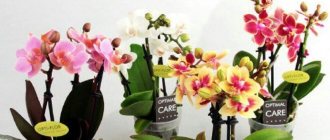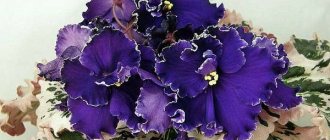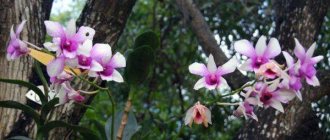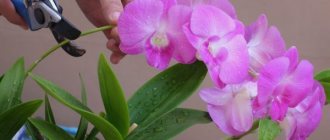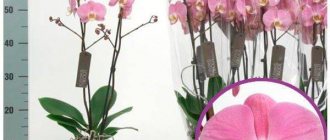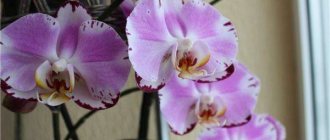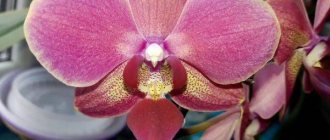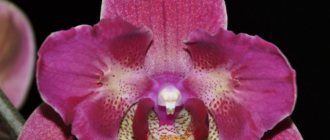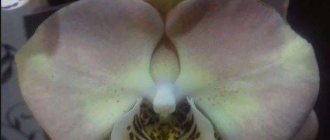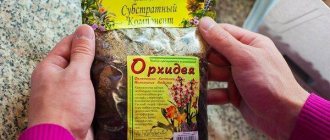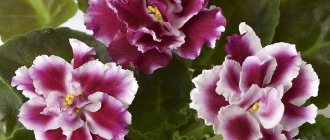After purchasing a beautiful orchid or receiving such an amazing gift, be sure to show interest in the following :
- To its name and origin. Or maybe it also has a tag with the name (not the price);
- And how to care for her. And not only - but how many times to water?
Their appearance on the flower market can be called rapid . Just yesterday, many knew almost nothing. Even the name was difficult to pronounce. And today we are already giving advice on how to grow it.
The history of their development is very interesting. After all, they were known and dealt with for quite a long time. Three thousand years ago exactly. They were in nature. Nowadays they are focusing more on hybrids .
And this is not surprising. After all, they come from places where there is plenty of moisture and warmth. Under natural conditions, they are well known to residents of Southeast Asia. Places are warm and humid.
In nature, orchids grow on the bark of trees.
In the mountains and plains. The southern regions of China are even considered their homeland. But you won’t see them on earth. They are epiphytes . Plants that grow on other plants. But they are called phorophytes .
Through the efforts and efforts of famous botanical travelers, they are now known :
- Georg Rumph in the seventeenth century spoke about such plants discovered in the Moluccas;
- Carl Lineus published the book "Species of Plants". And he called these flowers lovely epidendrum;
- It was named Phalaenopsis by Karl Blume . During his expedition, he confused flowers with moths. And they began to compare them to moths;
- And this was not the last name. You will also find the following names: Doritis;.
- Grafia;
- Lesliea;
- Sunadena;
- This is from history. And not only. More than 70 species are named alone.
- No trunk, no stem. Several evergreen dense elongated leaves: An adult plant has 4-6;
What the violet Frosty cherry looks like: description
This is a semi-double variety with juicy cherry-colored petals with a white or pale pink border and leaves of a pleasant even green color. The socket is standard size and compact.
Blooming Saintpaulia Frosty cherry selection Moreva
Plant characteristics
Violet is interesting primarily for its unusually lush and beautiful flowers. The diameter of the corolla reaches 4 cm. The petals are collected into a semi-double flower, in the center of which large yellow stamens are hidden. The edges of each petal have a smooth or wavy border of white or pink, and the central cherry spot has a noticeable shift from light to dark.
Variable petal color
The leaf is velvety with noticeable pile, it is green, elongated, heart-shaped. The surface has a matte sheen and is lumpy at the veins, creating a quilted effect. The petioles are long and pubescent. The root system is standard for Saintpaulias - branched, superficial.
For your information! Usambara indoor violets belong to the extensive genus Saintpaulia (Saintpaulia) of the Gesneriaceae family. Homeland - the highlands of North Africa (Tanzania, Kenya). Under natural conditions they grow along river terraces, next to waterfalls, where moisture is constantly present in the air.
The prominent Russian breeder K. Morev has been breeding the Frosty Cherry variety for at least 10 years. Today it can be purchased in specialized stores throughout the country and abroad.
Differences from the EK-Winter Cherry variety
Some similarity with the original variety authored by K. Morev is demonstrated by a violet with a similar name, bred by breeder E. Korshunova. But the two flowers are similar only at first glance; there are quite a lot of differences between them. Violet Winter cherry Korshunova has less double flowers with a diameter of not 4, but 7 cm. The border of a light pink shade along the edge of the petals is very narrow and sometimes almost invisible, and the middle is a denser, purple cherry tone. The leaf is larger and darker in color. In a word, it is impossible to confuse the sockets standing next to each other, although both are excellent.
Saintpaulia EK-Winter Cherry
Wanda
Magic (Vanda Magic Red)
A large flower with a long peduncle containing 4-8 flowers. The petals are painted bright red, turning into burgundy, ovoid in shape and wavy at the edges. The flower's tongue is yellow.
Kultana (Doctor Anake x Kultana Gold)
A stunning variety with up to 20 flowers on a long stem . Their diameter is from 10 to 15 cm, the ends of the petals are wavy, and the tongue is yellow-orange.
Useful properties and uses of violets
Varieties of mini orchids: planting, care and propagation at home
This indoor plant not only pleases household members with its beautiful flowering. Violet is actively used in folk medicine. It has anti-inflammatory, laxative and diuretic effects. Violet herb helps with bronchitis, sore throat, whooping cough, headaches, migraines. A decoction based on violet herb can be used for external and internal use. An infusion of violet flowers is used for convulsions, epilepsy, and tinnitus.
Popular folk recipes from violet leaves and flowers:
- For sore throat. Pour 50 g of plant flowers into 200 ml of alcohol. Close the lid and leave to infuse for 7 days. The prepared tincture is taken 30 ml before meals 3 times a day. To achieve an effective result, you can gargle with this tincture.
- When coughing. Take dried leaves and flowers in equal quantities of about 50 g. Next, pour a glass of hot water and leave to steep for a day. Then strain, heat slightly over low heat and sweeten. Take a teaspoon 4 times a day. The duration of treatment is about 7 days.
- For insomnia. Take 3-4 grams of flowers and pour boiled milk (200 ml). Leave in this state for 30 minutes. The prepared composition should be drunk before bed and the flowers should be eaten.
It is recommended to add violet decoction to bathing water for babies. With regular use, it helps to cure rickets, eczema, scrofula and skin rashes. When using violet to treat various diseases, remember that the plant is. It is recommended to consult a doctor before using decoctions and infusions based on violet leaves and flowers.
Video about the flowering of the violet “Frosty Cherry”:
Semi-double unusual cherry-red flowers with white center and border. Over time, the flower darkens and becomes more saturated. Additions The saturation of flowers increases over time and depends on the intensity of light. If a blooming violet is moved to an area with lower light intensity, it will begin to lighten over time. The variety loves warmer conditions, but reacts poorly to a combination of heat and high humidity (double flowers become simple). It is necessary to ventilate the room. At low temperatures, the overall dark color area decreases. Variety 2005 (Author's description) Taken from here
A very bright, colorful variety in my opinion. One of my favorites. Although, when a violet grows well and blooms wonderfully, one cannot help but like it.
I grew several bushes of this wonderful variety. I'll show you a few of them.
I can note that this is an early-blooming variety that can even bloom as children.
It is necessary to select the lighting mode; if there is not enough light, the cuttings can be pulled; if there is too much light, the center becomes clogged. Well, this applies to most varieties, with rare exceptions.
When cool, the variety blooms with a lot of white.
In the heat, there is a lot of red pigment, until the white disappears completely.
The flowers of the variety are large, but not from the first flowering.
It seemed to me that the variety loves the wick. But this is my personal opinion, others may not have the same opinion.
The leaves become darker with age than those of children.
At exhibitions, the variety attracts a record number of visitors with its brightness!
This variety will always be in my collection.
The photo below shows the first flowering of a young rosette during the heat.
Last photo.
I hope you enjoyed viewing photos of this variety.
Description of popular varieties of indoor Violet
Bessey sand cherry: description of the variety, cultivation and care features
Today, a large number of decorative forms are known, bred by modern breeders. The following varieties are most popular among gardeners:
Violet "Frosty Cherry"
Violet “Frosty Cherry” The plant is small. Multiple, long-petioled, hair-covered leaves emerge from a short stem. The flowers are semi-double, cherry-colored with a white border and center. The older the plant becomes, the richer the color of its flowers.
Violet "Sea Wolf"
Violet “Sea Wolf” This variety is large. The flowers are semi-double, wavy, shaped like a blue star with an openwork pattern. There are from 3 to 5 flowers on one peduncle. When the buds first open, they are bright blue, but over time the flowers become paler.
The leaf blades are dark green above and burgundy below. The leaves are glossy and torn. In bright light, the leaf blades may droop slightly.
Violet “Winter smiles”
Violet “Winter Smiles” Violets of this variety come in both semi-double and double. The flowers are large, with an unusual color: the light pink petals have wine-red strokes, and along the edges there is a light green border, reminiscent of braid. Peduncles are quite stable. There are 3-5 flowers on one peduncle.
The leaf blades are slightly elongated, round in shape, with jagged edges of a yellow tint. An unpretentious variety to grow.
Violet “Wedding Bouquet”
Violet “Wedding Bouquet” An unusually beautiful variety. The snow-white double flowers are especially decorative. These are ruffled stars with voluminous ruffles. In the center of the flower there is a yellow stamen. The flowers stay on the peduncle for a long time and do not fade.
The leaf blades are simple, light green in color with wavy edges.
Violet "Lyubasha"
Violet “Lyubasha” Has original soft pink double flowers, the diameter of which is 6 cm. The flowers are voluminous, shaped like a ball. Along the edges of the flower petals there is a border 2 mm wide in a white-light green color. The leaf rosette is light green. This variety blooms for a long time, flowering is abundant.
Violet “Magic of Love”
Violet “Magic of Love” An unusually beautiful variety that is grown with pleasure by lovers of indoor plants. Above the rosette of emerald green leaves rise the rounded stars of densely double flowers of a violet-red hue. The edging that runs along the edges of the petals, contrastingly with the main color of the flower, gives it special beauty. The variety is very easy to care for, even beginner gardeners can do it.
Violet "Beautiful Creole"
Violet “Beautiful Creole” The variety, thanks to its original flowers, is one of the most beautiful. Each flower is voluminous, double, curly, and wavy in shape. The size of the flower is about 4-5 cm, the color is dark blue. Up to 5-7 flowers can be located simultaneously on a strong peduncle. The leaf rosette is small, the leaf color is dark green.
Violet "Green Lagoon"
Violet “Green Lagoon” The violet of this variety is very fragile, but extremely beautiful. The flowers are large, double, fringed. The flower petals are white with blue strokes. The outer flowers are white. The shape of the flowers resembles cabbage.
The leaf blades are wavy and light green. The rosette is quite dense, the leaves are raised upward. “Green Lagoon” is very capricious in cultivation; often the buds simply do not open.
Phalaenopsis
Buddha (Phalaenopsis Buddha's Treasure)
This is a novelty phalaenopsis, so the flowers are not particularly large in size , because they form one lush inflorescence, like a cap. Up to 10 flowers can be located on one peduncle at the same time. The flower has only five petals and is ovoid in shape.
Jaguar (Phalaenopsis Red Jaguar)
It is a monohybrid of the giant phalaenopsis. This variety has very large buds of a juicy red color. However, this particular species is surprisingly capricious in home care, so it is extremely rare in flower growers’ collections.
Harlequin (Ever Spring King 'Lee')
The size of this orchid can vary from small to large, but the color is always spotted. Spots and stains are clearly visible already at the bud stage .
The color of flowers is always different; even on the same peduncle there can be different colors of buds: from slightly reddish to bright scarlet.
Kimono (Phalaenopsis Kimono)
This is the most beautiful flower that amazes everyone with its deep color who has ever seen it. The height of the orchid is up to 70 cm with a pair of arrows that have branches. Red-burgundy flowers reach a diameter of up to 10 cm. Sometimes a soft pink tint is visible, with the two side petals having a richer tone. The tongue in the middle is dark burgundy. Depending on the conditions and care of the plant, its saturation may vary .
Conditions of detention and care
Low and productive frost cherry: care and protection of the crop from birds
Violet Frosty cherry is warm and light-loving.
It is possible to achieve the correct flowering and development of the plant, characteristic of the variety, only if the following conditions are met:
- Sufficient illumination. The violet reacts to a lack of light by stretching out the peduncles and turning the flowers pale. Violet needs bright but diffused light, so it is better to install it on east or west windows. The leaves should not be exposed to direct sunlight, which will cause burns. Excessive light causes clogging of the center of the socket, so in summer it is better to shade it even on eastern and western windows.
- Air temperature from 20 to 25 degrees. A decrease or increase in temperature will not destroy the violet, but will affect flowering. In the heat, the flowers will be small, and at temperatures below 16 degrees the violet will stop blooming altogether.
- In insufficient light, the flowers of the Frosty cherry violet turn pale.
Air humidity is not less than 40 and not more than 65%. Heat combined with high humidity affects the flowers: they become simple, without terry. The room where the violet is located must be ventilated daily. The lack of moisture is compensated by installing open containers with water next to the violet. Spraying the plant to replenish moisture deficiencies is contraindicated.
- Regular watering with soft water at room temperature. The plant should be watered only after the soil has dried to a third of its height. Overwatering leads to rotting of the root system, and the plant may die.
Organization of fertilizing
Overfeeding violet Frosty cherries is harmful. The variety does not like nutrient-rich and dense soils. Such compositions inhibit the plant and reduce the quantity and quality of flowers. The violet begins to hurt.
If the plant shows signs of depression and begins to lose its attractiveness, it is recommended to replant and replace the soil. The soil needs to be poor in nutrients and as light as possible.
Adult plants are fed once every 2-3 weeks with organic and mineral compounds. Organic matter is added during the formation of the rosette, mineral mixtures are added during flowering. The first feeding is carried out 30 days after transplantation.
Transfer schedule and rules
Frost cherry violet is replanted twice a year. In this case, the size of the pot is gradually increased as the roots of the rosette grow. The maximum diameter of a pot for an adult violet is 12-13 centimeters.
A complete replacement of the soil during replanting is done if there is a suspicion of the presence of a disease.
If the plant looks healthy, transplantation is carried out together with a clod of earth. The slightest signs of trouble are a reason to completely replace the soil
In this case, remove the violet from the pot, carefully shake off the old soil from the roots and place the plant in a new pot.
To grow violets, you need the lightest and loosest possible soil. Special soil for violets is ideal, but to increase looseness you need to add perlite or vermiculite, approximately 10% of the total volume.
If it is not possible to purchase ready-made soil. You can prepare the substrate for planting yourself. The basis of the mixture is leaf or turf soil. It needs to be added to the mixture of 5 parts.
Add 3 parts peat and 1 part sand to the prepared soil. Then mix everything with vermiculite or perlite (10% of the total volume). For disinfection, a small amount of wood ash and sphagnum moss is added to the mixture.
Lady Marmalade
This variety has peach or pearlescent petals, sometimes with protruding dots. Lady Marmalade is distinguished by a yellow-orange lip of an unusual shape for orchids.
Huge buds are located on long peduncles. If the room is sufficiently lit, the petals will be lighter. The hybrid blooms twice a year, for a very long time, almost three months.
In nature, phalaenopsis shoots grow directly on the bark of trees. Therefore, the root system requires a large amount of oxygen. It is better to plant the plant in a transparent pot with holes and loose soil, which is placed in a flowerpot.
Care and conditions of detention
Despite the plant’s low maintenance requirements, it is important to create the most comfortable conditions for it. With the right approach, Saintpaulia will grow and develop correctly, delighting you with its regular, long-lasting and abundant flowering
Basic rules for caring for the “Frosty Cherry” violet include the following conditions:
- proper lighting;
- stable temperature regime;
- control over air humidity levels;
- compliance with the watering and fertilizing regime.
Fulfillment of these conditions will not only have a beneficial effect on the plant, but will also significantly reduce the risks associated with the development of diseases and pest invasions. Failure to follow the rules of care when growing Saintpaulias inevitably leads to a sharp decrease in the immunity of plants, as a result of which they become vulnerable and susceptible to diseases and pests.
Correct lighting
Usambara violet "Frosty cherry", like all Saintpaulias, is a light-loving plant. With a lack of light, its flower stalks begin to stretch out, the color of the flowers becomes pale, and the violet itself takes on a sickly appearance.
To avoid problems associated with lack of light, it is advisable to install pots with plants on window sills in the eastern or western part of the house. This arrangement will provide the violet with sufficient soft and diffused light.
It should be borne in mind that direct sunlight is detrimental to these beautifully flowering plants. If exposed to direct sunlight during the day, the violet can get burned. To prevent this, plants should be shaded in hot sunny weather, even if they are located on windowsills on the east or west side.
To achieve the longest possible flowering period, experienced plant growers recommend adding additional light to the plants, artificially increasing daylight hours. For this purpose, special phytolamps or ordinary fluorescent lamps are used.
Stable temperature conditions
The correct temperature regime is very important for such heat-loving plants as Saintpaulia. They feel most comfortable in a room where the temperature is maintained at +22°C. Temperature changes are very harmful for these delicate creatures.
A decrease in temperature to +16°C and below has a detrimental effect on flowering. In this case, the plants completely stop forming flower stalks and buds. However, a strong increase in temperature does not have the best effect on the condition of Saintpaulia flowers.
Suitable air humidity
Controlling the level of air humidity in the room where Uzambara violets grow is very important for the full development and flowering of plants. Experienced plant growers recommend ensuring that air humidity is consistently maintained at 50%.
An increase in air humidity to 65% or more can lead to a deterioration in the appearance of flowers. In this case, they go from intricately terry to simple and unsightly.
To prevent moisture deficiency in the air, it is advisable to install a wide bowl or tray with water near the plants. As water evaporates, it will saturate the air, replenishing moisture lost in hot weather.
It is also important to ensure that the air in the room is not only humid, but also fresh. Ensuring a flow of fresh air allows not only good ventilation, but also regular ventilation, during which plants should be temporarily removed from the room
Watering and fertilizing
Uzambara violets are sensitive to violations of watering and fertilizing. Plants should be watered as the soil dries out. The soil in the pot should be moderately moist, but not wet or damp. Excessive soil moisture can provoke the development of fungal infections and rot, so plants should not be flooded.
When watering, direct the stream of water strictly along the edge of the pot, making sure that it does not get on the leaves.
Saintpaulias are fed exclusively with complex fertilizers developed specifically for these plants. For the full development and flowering of violets, it is recommended to fertilize with mineral compounds approximately once every 2 weeks. The procedure should be carried out in the growth and flowering phases. During the dormant period, feeding is stopped.
You should not overuse fertilizing, since Saintpaulias are sensitive to excess nutrients in the soil. Inexperienced gardeners, trying to achieve more lush and abundant flowering, often make the mistake of overfeeding plants with fertilizers. The result is a result that is contrary to expectations, when violets begin to actively grow green mass, but stop blooming altogether.
Transplantation after purchase and during reproduction
It is recommended to transplant the plant from the shipping container into a new pot immediately after purchase. Often in stores flowers are in pots that are too large. For an adult Saintpaulia, the maximum pot diameter is 9 cm, and for young ones even less. Young violets, formed from a leaf or peduncle, must be planted in individual pots with a starting diameter of no more than 5 cm. When the young rosette has collected green mass, the next transplant occurs after 3-4 months into a pot with a diameter of 6 cm.
The soil must be mixed with disintegrants (sand, vermiculite, charcoal) to achieve high breathability. There is no need to put drainage at the bottom of the planting container, but the holes for watering must be large.
Note! Some gardeners who prefer wick watering, on the contrary, place more drainage at the bottom of a pot with one hole and place a wick in the soil, the end of which is immersed in a deep pan with water at the bottom
Main features of proper landing
How to choose soil?
- You don't have to choose the soil . It’s easier to buy ready-made in a specialized store... This is more for beginners;
- Experienced orchid lovers prepare it themselves. Yes, you can do it too. If you consider that it should contain : Pine bark (for minis, smaller pieces);
- Charcoal;
- Sand;
- Expanded clay (or pieces of foam);
- And sphagnum moss;
- But you can meet amateurs growing these flowers on formed blocks.
Capacity
- Consider the specific variety : For standard – size 10-15 cm in diameter;
- For Mini Mark - generally 6-9 cm;
- But midi needs a little more.
- And to observe the roots;
Transplant technology
There are no difficulties. There are some peculiarities. They must be observed :
- First place in a container with water. To soften the soil;
- Remove from pot;
- Let the roots dry;
- Carefully remove any remaining soil;
- Trim damaged roots;
- Fill the container with prepared fresh soil.
Note! Moisture should not be retained. Depending on the size of the variety, select the right soil (moss, small fractions for mini).
The nuances of transplantation
- Miniature orchids are replanted immediately after purchase in the store. Even if it blooms. This is the majority opinion. Especially Mini Mark. Which is often sold on a bed of sphagnum moss;
- I am familiar with a different opinion. During the flowering period, replanting is undesirable ;
- Experts and amateurs unanimously advise replanting once every two years. But no more than three years in one pot ;
- And the condition of each plant will tell you more.
Useful properties and uses of violets
This indoor plant not only pleases household members with its beautiful flowering. Violet is actively used in folk medicine. It has anti-inflammatory, laxative and diuretic effects. Violet herb helps with bronchitis, sore throat, whooping cough, headaches, migraines. A decoction based on violet herb can be used for external and internal use. An infusion of violet flowers is used for convulsions, epilepsy, and tinnitus.
Popular folk recipes from violet leaves and flowers:
- For sore throat. Pour 50 g of plant flowers into 200 ml of alcohol. Close the lid and leave to infuse for 7 days. The prepared tincture is taken 30 ml before meals 3 times a day. To achieve an effective result, you can gargle with this tincture.
- When coughing. Take dried violet leaves and flowers in equal quantities, about 50 g. Next, pour a glass of hot water and leave to steep for a day. Then strain, heat slightly over low heat and sweeten. Take a teaspoon 4 times a day. The duration of treatment is about 7 days.
- For insomnia. Take 3-4 grams of flowers and pour boiled milk (200 ml). Leave in this state for 30 minutes. The prepared composition should be drunk before bed and the flowers should be eaten.
It is recommended to add violet decoction to bathing water for babies. With regular use, it helps cure rickets, eczema, scrofula and skin rashes. When using violet to treat various diseases, remember that the plant is poisonous. It is recommended to consult a doctor before using decoctions and infusions based on violet leaves and flowers.
Video about the flowering of the violet “Frosty Cherry”:
If you place a blooming Saintpaulia of this variety in an area with less light, then the petals of the violet variety Winter Cherry will begin to lighten. Indoor flowers of the Frost Cherry species prefer warm climates, because their ancestors come from West Africa, but do not tolerate high temperatures combined with high humidity. In the cold, the intensity of the shade becomes weaker.
If the temperature outside the window is low, white color predominates in the flowers, and in the heat red dominates, to the point that the white areas on the petals of Saintpaulia may completely disappear. The flowers of this variety are large in size, but this feature is noticeable from the second and subsequent blooms. It may seem that plants of this variety bloom better when lit by a candle, but this is most likely a subjective feeling.
As for the leaves, in young plants they are a little lighter than in mature Saintpaulias. It should be noted that at various exhibitions of indoor flowers, violets of the Frosty cherry variety are always popular among visitors because of their bright and rich color.
Growing conditions
In order for our plant to bloom for a long time, it is necessary to comply with certain care conditions.
Selecting a location
This variety blooms for quite a long time, but the intensity of flowering depends on how correctly you position it.
Expert opinion
Nesterenko Ilona Mikhailovna
Florist, specialist in indoor plants. The owner of a country house with a garden and vegetable garden
Lighting plays a huge role. In order for the flowers to have bright, rich shades, a sufficient amount of light is necessary. If there is not enough of it, the flowers will fade over time.
Lack of light will also affect the leaves. The disadvantage will be expressed in the lengthening of the cuttings, and if there is an excess of light, the middle will become clogged.
It is recommended to place Saintpaulia on the east or west side. When located on the south side, try to exclude direct sunlight, which is harmful to it.
Selection of pot
Which pots are better?
ClayPlastic
It is best to use a plastic container for planting; such pots have many holes, which improves root aeration.
Their walls are smooth, which prevents roots from attaching to them and, as a result, damage during transplantation.
Important! When reusing a plastic pot, place it in soapy water for a couple of hours. For disinfection
Internal salt deposits are also removed.
We calculate the size of the pot so that its size is 2/3 smaller than the rosette itself. Replant only when the volume of the plant increases.
Neglecting advice when choosing a pot can ruin the plant. The roots of violets are not very developed in depth; by using a large container, we “provoke” the root system to fill the entire volume.
This will affect the poor development of the above-ground part.
Soil selection
For violets, it is necessary to use specially selected soil, which includes all the necessary micro and macroelements.
If you can’t buy it in a store, you can mix the soil yourself. To do this you will need:
- Garden or turf soil.
- Baking powder (vermiculite or perlite).
- Peat.
It is allowed to use a soilless mixture. It is prepared on the basis of peat, with the addition of raising agents.
A special feature is the complete lack of nutrients. You add fertilizer yourself at your own discretion.
Whatever option you use, the land must be:
- Easy.
- Breathable.
- Moisture-intensive.
- Not infected.
- With acidity 5.5-6.5 pH.
- With live microflora.
- With a set of necessary micro and macroelements.
Watering
Health and active growth largely depend on proper watering. The amount depends on many factors.
Periods when the plant requires increased watering:
- Increased room temperature (summer, heater operating nearby).
- Placement on the sunny side.
- Flowering time.
- Growth period (spring-autumn).
If for some reason the plant is not healthy or is in a cool room, then the amount of water consumed should be reduced, but not eliminated.
Remember! If the violet you bought was on “wick” watering, drying out the soil is disastrous for it. Its roots are accustomed to moist soil.
When watering, not only the quantity of water is important, but also the quality. Be sure to use settled water at room temperature
Temperature and humidity
This variety is the most unpretentious in terms of temperatures.
It is not afraid of changes and blooms beautifully both in winter and summer.
Important! Frosty cherries do not tolerate high temperatures and high humidity. Flowers lose their fullness
In winter, when the temperature becomes lower, white color predominates on the bush.
As the temperature rises, the color becomes brighter, and white may disappear completely.
An increase in temperature will affect the size of the flowers, they become smaller.
Feeding
For Saintpaulias, special fertilizers designed specifically for them are used. But when using, you should be careful and not overdo it with application.
For young plants, fertilizers with a high N (nitrogen) content are used. It allows you to increase green mass. Before bud formation and during flowering, use K (potassium) and P (phosphorus).
It is recommended to apply fertilizer to the substrate using the root method.
It is not recommended to fertilize the plant in winter. Violet should rest and gain strength.
Limelight
This hybrid has a small peduncle, the flowers are medium-sized, but bright, lemon-colored. The lip is terracotta with purple highlights.
The plant blooms up to 5 times a year. This is a kind of record for orchids. It is quite difficult to determine the rest period of Limelight.
Phalaenopsis is usually fed in the summer using diluted fertilizer. Once every two years it is transplanted into a slightly larger container. This must be done with great care so as not to damage the roots.
Water the orchid, lowering it halfway into soft, settled water at room temperature. Excess moisture must drain off.
Consistent growing process
Landing
If you bought an already mature plant, ready to bloom, or already blooming, then you need to take a low pot without drainage. The composition of soil for violets is suitable: 3 parts peat, 1 part Vermion soil and 1 part baking powder. They do not like dense, heavy soils; remember that the soil should be light and loose.
ATTENTION! When planting violets with seeds, there is no guarantee that the flower will inherit all the maternal characteristics. When planting violets with cuttings, there are some features:
When planting violets with cuttings, there are some features:
- Wash the leaf with the stalk, cut off the excess, leaving 2 cm of the petiole;
- plant in a plastic cup with holes made at the bottom;
- Poor soil is suitable, consisting of peat and baking powder (polystyrene chips or coarse sand);
- install the leaf so that only the petiole is in the ground;
- insulate the cup by covering it, for example, with a cut-off plastic bottle or bag.
During the rooting period, you do not need a lot of light. After 3-4 weeks, the plant will develop roots. After another month, small new leaves appear. After another 3-4 months, remove the old mother sheet. And the bush itself can be divided and planted separately, several young leaves each.
Height
When growing Uzambara violets of the Frost Cherry and Winter Cherry varieties, a special mixture for Saintpaulias is usually taken. But you can take a mixture of coniferous, turf, and leaf soil, add a little peat and baking powder.
These varieties of violets do not like large pots, because their roots are located in the top layer of soil. Low dishes are suitable for them. You can use plastic containers of suitable sizes. Does not require drainage.
